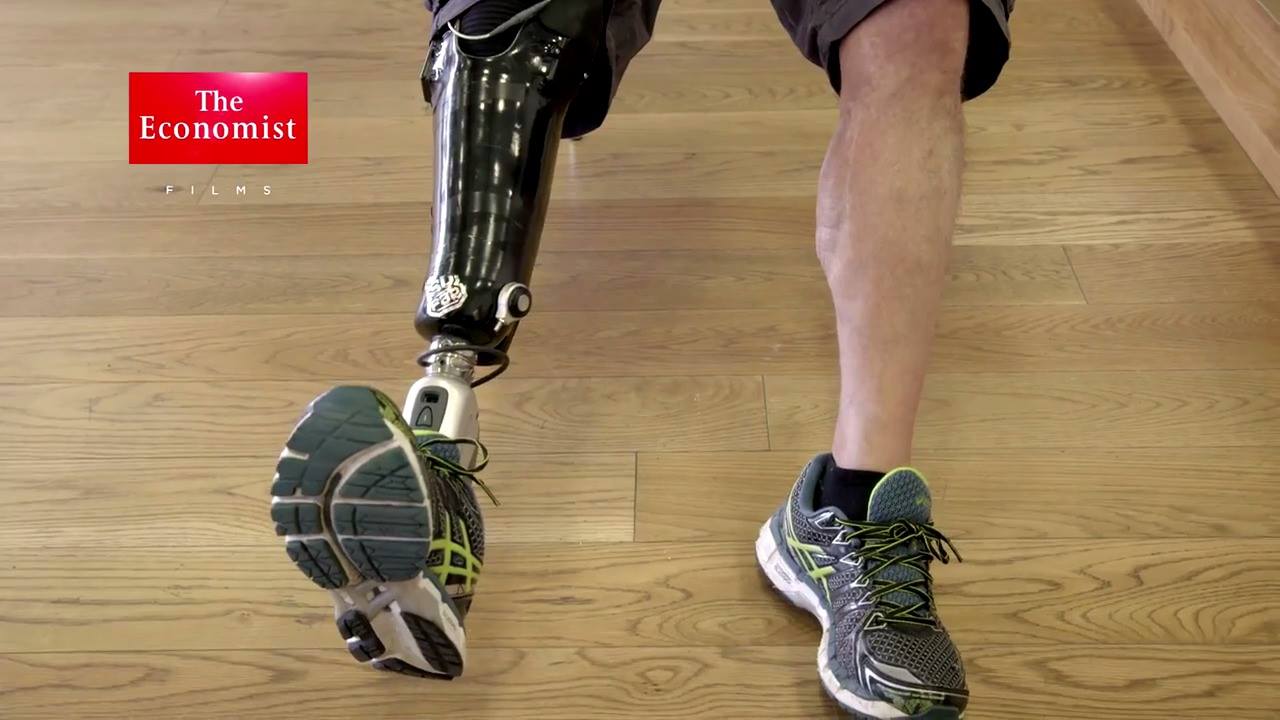Bionics: surgically inserted sensors controlling a prosthetic limb. Meet the man who sometimes forgets that his bionic leg is not his own.



Futurist Ray Kurzweil talks with StarTalk Radio’s Neil DeGrasse Tyson about the expansion of the human brain that he predicts will happen in the 2030’s.
Subscribe for more videos like this: http://bit.ly/1GpwawV
Facebook: http://facebook.com/92ndStreetY
Twitter: https://twitter.com/92Y
Tumblr: http://92y.tumblr.com/
Instagram: http://Instagram.com/92ndStreetY
Vine: https://vine.co/92Y
On Demand: http://www.92yondemand.org

Allen Institute working with Baylor on reconstructing neuronal connections.
The Intelligence Advanced Research Projects Activity (IARPA) has awarded an $18.7 million contract to the Allen Institute for Brain Science, as part of a larger project with Baylor College of Medicine and Princeton University, to create the largest ever roadmap to understand how the function of networks in the brain’s cortex relates to the underlying connections of its individual neurons.
The project is part of the Machine Intelligence from Cortical Networks (MICrONS) program, which seeks to revolutionize machine learning by reverse-engineering the algorithms of the brain.
“This effort will be the first time that we can physically look at more than a thousand connections between neurons in a single cortical network and understand how those connections might allow the network to perform functions, like process visual information or store memories,” says R. Clay Reid, Ph.D., Senior Investigator at the Allen Institute for Brain Science, Principal Investigator on the project.
The preview image below thanks Robert Bradbury(no not Ray Bradbury) who is no longer with us but you can find his work concerning Matrioshka Brains and he has a great life extension lecture on youtube.
The author greatly appreciates and thanks Robert J. Bradbury for doing the painstaking and often tedious original html coding job for 25 of these papers, among the many linked papers cited on this page.
Last updated on 6 July 2013.

The realities of VR.
NEW YORK, March 7, 2016 /PRNewswire/ — Horizon Media, the largest and fastest growing privately held media services agency in the world, announced today its most recent research on consumer interest in virtual reality devices. The research was fielded in Finger on the Pulse, the agency’s proprietary online research community comprised of 3,000 people reflective of the U.S. population, and with the social media expertise of Horizon’s Distillery social intelligence team. The research shows that despite extensive media coverage of Oculus Rift, Samsung Gear VR, Google Cardboard and other virtual reality devices, fully two thirds of consumers are unaware of the technology.
Virtual reality – often referred to as “VR” – has been readily embraced by the mainstream media as the shiny, new, technological advancement. Marketers are also understandably excited about the possibilities unleashed by VR technology. But while there is interest among consumers, the survey findings suggest that companies would be well served to walk before they run when incorporating virtual reality activations into marketing plans, at least until the technology reaches greater awareness and scale.
Consumers are open to a VR enhanced future, but believe it will take several more years to get there. Unaided awareness of the major devices is fairly low at just 33%. However, more than a third (36%) say they are interested in owning some sort of virtual reality device. In addition Horizon’s Distillery social intelligence team found that 9% of online discussion around the topic is related to positive purchase interest. In fact, compared to the Apple Watch before its release, VR got much more love from Finger on the Pulse panelists. Twice as many consumers consider VR “an exciting new innovation to own” (82% for VR vs. 44% for Apple Watch), and twice as many say “everyone is going to wish they owned one” (55% for VR vs. 24% for Apple Watch). A strong majority of consumers (81%) also believe that five years from now, anywhere from a quarter to half of the population will own a VR device.


I have spent the last 30 years in various aspects of the biopharmaceutical industry, which for the most part has been a very rewarding experience.
However, during this time period, having been immersed many different components of therapeutic development and commercialization, one thing has always bothered me: a wide array of promising research never makes it off the bench to see the translational light of day, and gets lost in the historical scientific archives.
I always believed that scientific progress happened in a very linear narrative, with each new discovery supporting the next, resulting ultimately in an eventual stairway of scientific enlightenment.
What the reality turned out to be was much more of a fragmented, research “evolutionary tree”, with dozens of potential pathways, only very few branches of which ever resulted in scientific maturity, and not always the most fruitful ones by any means.
The premature extinction of these promising discovery pathways were the result of a variety of factors, including, but not limited to, funding priorities, competing industrial interests, “out of vogue” concepts, lack of intellectual properties, non-existent regulatory models, conflicted legislative initiatives, and even religious implications.
In 2016, as in previous years, we continue to see these “valleys of death” swallow up pathways of scientific possibility, with few popular segments attracting the majority of attention and support.
The preponderance of resources focused on the somatic mutation model of carcinogenesis, despite an endless range of research highlighting that the disease is extremely heterogenic and rarely ever follows such a clonal model, is one example that continues to be inappropriately manifested in the oncology system, decades into the “war on cancer”.
On a similar plane, the jettisoning of most studies of the biophysical aspects of human genetics, despite the gross incompleteness offered by the central dogma to explain higher biological form and function, is another example that has become all too pervasive in the research community.
And then there are the areas of human consciousness, memory, and information processing / storage, where in many ways we are still operating in the dark ages, with materialists and dualists battling it out for centuries.
One topic that I have written quite a bit about is that of death, specifically that of the death of the human brain — http://www.singularityweblog.com/is-death-reversible/
While I am a staunch supporter and advocate of the life-extension / anti-aging movement, I am equally vocal about our need to develop technologies, products, and services that can actually reverse our ultimate transition between the living and dead states, a transition that occurs annually for 60 million humans around the globe.
Death, however, is unfortunately seen by many as a natural, biological progression for human beings, and in many circles, deemed an unnecessary area of scientific research and exploration.
I beg to differ.
Far too often, death arrives too early and too unexpectedly for many of us and our loved ones. And the best modern medicine has to offer today is “Sorry. There is nothing else we can do.”
But what if there was?
There are a variety of species across the natural world that are capable of regenerating and repairing themselves from forms of severe CNS damage that bring them to the transitional grey zone between life and death. Along the evolutionary timeline however, this ability gradually disappeared hundreds of millions of years ago and does not manifest in higher species.
Now, in the 21st century, with the convergence of the disciplines of regenerative biology, cognitive neuroscience, and clinical resuscitation, we may finally be poised to take back these capabilities for humans.
Over the years, clinical science has focused heavily on preventing such life and death transitions and made some initial progress with suspended animation technologies, such as therapeutic hypothermia. But once we transition through the brain death window, currently defined by the medical establishment as “irreversible” (per the 1968 Ad Hoc Committee of the Harvard Medical School definition), we are technically no longer alive.
To add insult to injury, a human can be declared dead, even while our bodies can still circulate blood, digest food, excrete waste, balance hormones, grow, sexually mature, heal wounds, spike a fever, and gestate and deliver a baby. It is even acknowledged by thought leaders that recently brain dead humans still may have residual blood flow and electrical nests of activity in their brains, just not enough to allow for an integrated functioning of the organism as a whole.
Several prominent cases in the media over the past few years have further served to highlight the current situation, as well as the substantial anatomical and functional differences between the state known as brain death, and other severe disorders of consciousness, such as coma, and the vegetative and minimally conscious states.
It is now time to take the necessary steps to provide new possibilities of hope, in order to counter the pain, sorrow, and grief that is all too pervasive in the world when we experience a loved one’s unexpected or untimely death, due to lesions which might be potentially reversible with the application of promising neuro-regeneration and neuro-reanimation technologies and therapies.
It is time to undertake the required research, based on 2016 technological knowledge, in order to bring about such transformational change.
My name is Ira S. Pastor and I am the CEO of the biotechnology company Bioquark Inc.
Welcome to the unveiling of the Reanima project.

US Government’s cool $100 mil in brain research. As we have been highlighting over the past couple of months that the US Government’s IARPA and DARPA program’s have and intends to step up their own efforts in BMIs and robotics for the military; I am certain that this research will help their own efforts and progress.
Intelligence project aims to reverse-engineer the brain to find algorithms that allow computers to think more like humans.
By Jordana Cepelewicz on March 8, 2016.

Virtual and augmented reality is taking giant leaps every day, both in the mainstream and in research labs. In a recent TechEmergence interview, Biomedical Engineer and Founder of g.tec Medical Engineering Christopher Guger said the next big steps will be in brain-computer interfaces (BCIs) and embodiment.
Image credit: HCI InternationalIf you’re unfamiliar with the term, embodiment is the moment when a person truly “feels” at one with a device controlled by their thoughts, while sensing that device as a part of, or an extension, of themselves. While researchers are taking big strides toward that concept, Guger believes those are only baby steps toward what is to come.
While augmented or virtual reality can take us away for a brief period, Guger said true embodiment will require far more BCI development. There has been a lot of work recently in robotic embodiment using BCI.
“We have the robotic system, which is learning certain tasks. You can train the robotic system to pick up objects, to play a musical instrument and, after the robotic system has learned, you’re just giving the high-level command for the robotic system to do it for you,” he said. “This is like a human being, where you train yourself for a certain task and you have to learn it. You need your cortex and a lot of neurons to do the task. Sometimes, it’s pre-programmed and (sometimes) you’re just making the high-level decision to do it.”
Another tool at work in the study of embodiment is what Guger called “virtual avatars.” These virtual avatars allow researchers to experiment with embodiment and learn both how avatars need to behave, while also helping humans grow more comfortable with the concept of embodiment inside the avatar. Being at ease inside the avatar, he said, makes it easier for one to learn tasks and train, or re-train, for specific functions.
As an example, Guger cited a stroke patient working to regain movement in his hand. Placing the patient into a virtual avatar, the patient can “see” the hand of the avatar moving in the same manner that he wants his own hand to move. This connection activates mirror neurons in the patient’s brain, which helps the brain rewire itself to regain a sense of the hand.
“We also do functional electrical stimulation (where) the hand is electrically stimulated, so you also get the same type of movement. This, altogether, has a very positive effect on the remobilization of the patient,” Guger said. “Your movement and the virtual movement, that’s all feeding back to the artificial systems in the cortex again and is affecting brain plasticity. This helps people learn to recover faster.”
One hurdle that researchers are still working to overcome is the concept of “break in presence” (discussed in the article under the sub-heading ‘head-tracking module’). Basically, this is the moment where one’s immersion in a virtual reality world is interrupted by an outside influence, leading to the loss of embodiment. Avoiding that loss of embodiment, he said, is what researchers are striving to attain to make virtual reality a more effective technology.
Though Guger believes mainstream BCI use and true embodiment is still a ways off, other applications of BCI and embodiment are already happening in the medical field. In addition to helping stroke patients regain their mobility, there are BCI systems that allow doctors to do assessments of brain activity on coma patients, which provides some level of communication for both the patient and the family. Further, ALS patients are able to take advantage of BCI technology to improve their quality of life through virtual movement and communication.
“For the average person on the street, it’s very important that the BCI system is cheap and working, and it has to be faster or better compared to other devices that you might have,” he said. “The embodiment work shows that you can really be embodied in another device; this is only working if you are controlling it mentally, like the body is your own, because you don’t have to steer the keyboard or the mouse. It’s just your body and it’s doing what you want it to do. And then you gain something.”